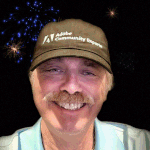- Home
- Photoshop Elements
- Discussions
- Re: When using a Guided Edit to remove part of pic...
- Re: When using a Guided Edit to remove part of pic...
Copy link to clipboard
Copied
 2 Correct answers
2 Correct answers
Elements can sometimes do the impossible. Miracles take a little longer. 😉
The person you are trying to remove in the image covers up too much of the clothing of the man to get a good result via a Guided Edit. The program has to guess what that clothing looks like and/or replace it with surrounding pixels.
You would have to work in Expert Mode with the Clone tool. Here, I would copy the right side of the man's shirt and press Ctrl+J. This will create a new layer of just the shirt. I w
...The problem is not to 'remove' 'ghost images. It's to 'fill' the gap created from deleting the object. No problem if the object is included in a flat, monochrome background. The specific effect of the 'remove' object is that AI (artificial intelligence) searches for ways to fill the gap by an extrapolation of the contents of the 'outside' of the gap towards the center. For instance if you want to mask a face with a vegetal background like in your example, the filling will look natural. However,
...Copy link to clipboard
Copied
Elements can sometimes do the impossible. Miracles take a little longer. 😉
The person you are trying to remove in the image covers up too much of the clothing of the man to get a good result via a Guided Edit. The program has to guess what that clothing looks like and/or replace it with surrounding pixels.
You would have to work in Expert Mode with the Clone tool. Here, I would copy the right side of the man's shirt and press Ctrl+J. This will create a new layer of just the shirt. I would the drag the handles of the new layer to reverse it horizontally. Move the layer into place and use the Clone Stamp tool to make it look more realistic. It takes a couple of minutes (or more for a better result) but you can get something like this:
Copy link to clipboard
Copied
Thank for your input - as a beginner I find the programming overwhelming! There is so much!
Copy link to clipboard
Copied
The problem is not to 'remove' 'ghost images. It's to 'fill' the gap created from deleting the object. No problem if the object is included in a flat, monochrome background. The specific effect of the 'remove' object is that AI (artificial intelligence) searches for ways to fill the gap by an extrapolation of the contents of the 'outside' of the gap towards the center. For instance if you want to mask a face with a vegetal background like in your example, the filling will look natural. However, in your example, the object has everything to make the process fail:
- huge object relative to the whole image
- lack of significant existing background outside of the object
- heterogenous background all around
- object situated too near the borders.
So, you can't expect the effect to work in similar source images.
Even if you asked a painter to fill the gap using the surrounding heterogenous background, his natural intelligence would have a hard time making something out of the very different surrounding shirts patterns!
Copy link to clipboard
Copied
This is true - sometimes it takes the input of an expert to explain what is or is not possible. I now realize that this picture is such that it cannot successfully be corected. Thank you!


